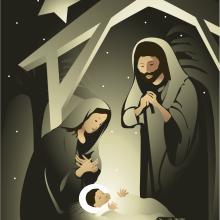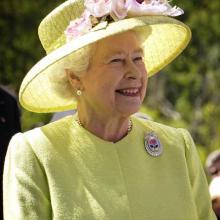Elizabeth
Sculpture of Mary and Elizabeth and Church of the Visitation in Jerusalem. Creative Commons license.
In America, baby showers are times for women to come together and celebrate new life; presents are exchanged, advice given, and games played. Mary and Elizabeth celebrated the new life within them by exchanging presents of joy, encouragement, song, and prophecy. Both women were carrying children of promise. Neither woman had a convenient pregnancy. Mary and Elizabeth’s celebration shows the importance of women coming together for prayer, praise, and prophecy.
The Metropolitan Museum of Art, on its website, has a wonderful slide show of paintings from the renaissance depicting the birth of Christ. This time of year those beautiful works of art often come to us through reproductions on Christmas cards. My husband and I support several charities that work in the emerging world so we also receive cards with nativity scenes reflecting cultures from across Africa and Latin American. Some of my favorite cards are the ones with nativity scenes from the Caribbean; I love their bright colors and exuberance.
Each of these cards, whatever the source, offers a different perspective on the birth of Christ; each presents a different emotion: serenity, joy, often the quiet peace associated with Christmas. What the artwork doesn’t convey, what our Christmas card may not fully be able to convey is the magnitude of Christ’s birth. Maybe the magnitude of this truly cataclysmic event is better depicted with words. And maybe there are no greater words then those of Mary.
The birth Christ ushers in peace through upheaval. It is a radical event. With the birth of Christ the world is turned upside down. Existing authority is challenged. Kings so terrified that their rage leads to mass killings. The significance of this night is not so gentle, not so calm. Not so much mentioned in our Christmas cards.
LONDON — As Britain awaits the appointment of the next archbishop of Canterbury to lead both the Church of England and the far-flung Anglican Communion, there's renewed attention on the woman who officially gets the final say: Queen Elizabeth II, the "Defender of the Faith."
The current archbishop, Rowan Williams, ends his 10-year tenure in December. A Church of England committee is sifting through candidates — two of whom will be submitted to Prime Minister David Cameron, whose top choice will be submitted to the queen for final approval.
When he announced his retirement last March, Williams, 62, famously said his successor will need "the constitution of an ox and the skin of a rhinoceros.”
Politicians and religious leaders say the next archbishop will need those qualities and more to handle deep divisions in the British church over female bishops and North/South divisions among his 77 million-member global flock over sexuality.
But he'll also need something else: the ability to envision life when Elizabeth — who turns 87 next year — is no longer on the throne, and when Britain is no longer a Christian-majority country.


